Activity Spaces in Multimodal Transportation Networks: A Nonlinear and Spatial Analysis Perspective
Abstract
1. Introduction
2. Literature Review
2.1. Conceptualization and Measurement of Activity Space
2.2. Activity Space–Travel Behavior Research
3. Methodology
3.1. Extraction of Complete Travel Chains
3.2. Measurement and Analysis of Multimodal Transportation Activity Space
3.3. XGBoost
3.4. GeoShapley
4. Data and Variables
4.1. Study Area and Data Sources
4.2. Activity Space Analysis
4.3. Variables
4.3.1. Dependent Variable
4.3.2. Independent Variable
- (1)
- Density
- (2)
- Diversity
- (3)
- Design
5. Results and Analysis
5.1. Relative Importance of Explanatory Variables
5.2. Nonlinear Relationship Analysis of Key Variables
5.3. Geospatial Effect Analysis
6. Conclusions and Policy Implication
- (1)
- By integrating bus and metro smart card data, we extract detailed multimodal travel chains that record residents’ origins, destinations, travel durations, and transport modes. A total of 453,863 B-R/R-B travel chain data points were obtained, including 209,225 B-R travel chain data points and 244,638 R-B travel chain data points. These chains offer a comprehensive view of urban public transit use across multiple modes.
- (2)
- Using grid-based analysis and confidence ellipses, we measured the spatial extent of activity spaces under different travel modes. Compared with single-mode travel (bus-only or metro-only), multimodal travel significantly enlarges residents’ activity spaces, demonstrating the spatial complementarity between transport modes.
- (3)
- The research results indicate that the characteristics of multimodal transportation activity space are influenced not only by transportation infrastructure but are also closely related to urban environmental characteristics and socioeconomic features. Specifically, factors such as the distance to the nearest metro station, the distance to the CBD, the distribution of commercial facilities, and GDP exhibit significant nonlinear characteristics in their influence on the activity space of multimodal transportation residents, and the interaction between the distance to the nearest metro station and geographic location also produces strong spatial effects. Through the combination of the XGBoost and GeoShapley models, we can deeply understand the key factors influencing multimodal transportation activity space and their spatial interactions.
- (1)
- Optimize transportation infrastructure layout and enhance service coverage. This policy is supported by the geospatial interaction analysis in Figure 15. The analysis reveals that in central areas such as Xihu District, Binjiang District, and downtown Hangzhou, the distance to the nearest metro station shows a weak correlation with residents’ activity spaces. In contrast, this correlation is much stronger in peripheral areas, indicating an unmet demand for public transit. These findings suggest that expanding public transportation infrastructure in under-served regions could significantly enhance residents’ mobility and unlock latent travel potential, thereby improving spatial equity in the access to urban opportunities [6,49].
- (2)
- Enhance mobility support for low-income populations. The recommendation to enhance mobility support for low-income populations is directly informed by the nonlinear relationship shown in Figure 13. The study finds that the multimodal transportation activity space of low-income groups is relatively limited [34]. It is therefore recommended that transportation policies incorporate targeted subsidies and service improvements for low-income areas [50]. In future research, it would also be valuable to examine the integration of public transportation with green travel modes, such as cycling, to explore how more diversified and sustainable travel options could benefit low-income populations. These directions may contribute to improving mobility equity while supporting the broader goals of sustainable urban development and social inclusion.
- (3)
- Implement differentiated strategies to expand residents’ activity spaces. The recommendation to implement differentiated strategies for commercial facility planning is grounded in the threshold effect observed in Figure 12. Priority should be given to planning small, convenient commercial facilities (such as convenience stores and community markets) in areas with a lower density of commercial POIs (e.g., communities with POI numbers < 200), thereby stimulating the potential for residents’ activity space by enhancing basic commercial accessibility; whereas in areas where POIs are saturated (e.g., POI > 200), the focus should shift to optimizing the commercial format and spatial distribution (such as reducing homogeneous shops and increasing open spaces like community plazas). Low-density areas should focus on “incremental quality improvement”, and high-density areas on “stock optimization”. This is in line with the “diseconomies of agglomeration” theory in new economic geography research [51] and the principle of supply–demand balance in public spaces, thereby avoiding diminishing marginal returns due to over-agglomeration, and achieving the efficient expansion of residents’ activity space through differentiated strategies.
- (4)
- Our findings offer tangible tools for planners. The geospatial effect maps (Figure 14 and Figure 15) can be used as a diagnostic tool to identify ‘transportation potential area’ where the distance to a metro station strongly and negatively impacts residents’ mobility. These areas, particularly in the urban periphery, should be prioritized for investment in feeder bus services or new transit infrastructure.
Limitation
Author Contributions
Funding
Data Availability Statement
Acknowledgments
Conflicts of Interest
Appendix A
References
- Makarova, I.; Shubenkova, K.; Pashkevich, A. Efficiency Assessment of Measures to Increase Sustainability of the Transport System. Transport 2021, 36, 123–133. [Google Scholar] [CrossRef]
- Hasanzadeh, K.; Kyttä, M.; Lilius, J.; Ramezani, S.; Rinne, T. Centricity and multi-locality of activity spaces: The varying ways young and old adults use neighborhoods and extra-neighborhood spaces in Helsinki Metropolitan Area. Cities 2021, 110, 103062. [Google Scholar] [CrossRef]
- Cagney, K.A.; York Cornwell, E.; Goldman, A.W.; Cai, L. Urban Mobility and Activity Space. Annu. Rev. Sociol. 2020, 46, 623–648. [Google Scholar] [CrossRef]
- Zheng, N.; Geroliminis, N. On the Distribution of Urban Road Space for Multimodal Congested Networks. Procedia-Soc. Behav. Sci. 2013, 80, 119–138. [Google Scholar] [CrossRef]
- Gong, L.; Jin, M.; Liu, Q.; Gong, Y.; Liu, Y. Identifying Urban Residents’ Activity Space at Multiple Geographic Scales Using Mobile Phone Data. ISPRS Int. Geo-Inf. 2020, 9, 241. [Google Scholar] [CrossRef]
- Gao, Q.-L.; Yue, Y.; Zhong, C.; Cao, J.; Tu, W.; Li, Q.-Q. Revealing transport inequality from an activity space perspective: A study based on human mobility data. Cities 2022, 131, 104036. [Google Scholar] [CrossRef]
- Litman, T. Toward More Comprehensive and Multi-Modal Transport Evaluation; Citeseer: University Park, PA, USA, 2013. [Google Scholar]
- Liu, Y.; Ji, Y.; Feng, T.; Timmermans, H. Understanding the determinants of young commuters’ metro-bikeshare usage frequency using big data. Travel Behav. Soc. 2020, 21, 121–130. [Google Scholar] [CrossRef]
- Fu, X.; Lam, W.H.; Meng, Q. Modelling impacts of adverse weather conditions on activity–travel pattern scheduling in multi-modal transit networks. Transp. B Transp. Dyn. 2014, 2, 151–167. [Google Scholar] [CrossRef]
- Du, M.; Li, X.; Kwan, M.-P.; Yang, J.; Liu, Q. Understanding the Spatiotemporal Variation of High-Efficiency Ride-Hailing Orders: A Case Study of Haikou, China. ISPRS Int. Geo-Inf. 2022, 11, 42. [Google Scholar] [CrossRef]
- Li, Q.; Cui, C.; Liu, F.; Wu, Q.; Run, Y.; Han, Z. Multidimensional Urban Vitality on Streets: Spatial Patterns and Influence Factor Identification Using Multisource Urban Data. ISPRS Int. Geo-Inf. 2022, 11, 2. [Google Scholar] [CrossRef]
- Deng, X.; Jiang, S. An Overview about Research on 3D Visualization Technology of Geographic Information Based on Computer Software Development. J. Phys. Conf. Ser. 2020, 1648, 032124. [Google Scholar] [CrossRef]
- Chai Yan-Wei, S.J. Activity-based Approach to Human Spatial Behavior Research. Sci. Geogr. Sin. 2008, 28, 594–600. [Google Scholar] [CrossRef]
- Wang, D.; Li, F.; Chai, Y. Activity Spaces and Sociospatial Segregation in Beijing. Urban Geogr. 2012, 33, 256–277. [Google Scholar] [CrossRef]
- Na, T.A.; Yanwei, C. Disciplinary position and research frontiers of behavioral geography. Prog. Geogr. 2022, 41, 1–15. [Google Scholar] [CrossRef]
- Shen Yue, C.Y. Daily activity space of suburban mega-community residents in Beijing based on GPS data. Acta Geogr. Sin. 2013, 68, 506–516. [Google Scholar] [CrossRef]
- Hägerstrand, T. What about people in Regional Science? Pap. Reg. Sci. Assoc. 1970, 24, 6–21. [Google Scholar] [CrossRef]
- Miller, H.J. Modelling accessibility using space-time prism concepts within geographical information systems. Int. J. Geogr. Inf. Syst. 1991, 5, 287–301. [Google Scholar] [CrossRef]
- Dijst, M. Two-earner families and their action spaces: A case study of two Dutch communities. GeoJournal 1999, 48, 195–206. [Google Scholar] [CrossRef]
- Newsome, T.H.; Walcott, W.A.; Smith, P.D. Urban activity spaces: Illustrations and application of a conceptual model for integrating the time and space dimensions. Transportation 1998, 25, 357–377. [Google Scholar] [CrossRef]
- Buliung, R.N.; Kanaroglou, P.S. A GIS toolkit for exploring geographies of household activity/travel behavior. J. Transp. Geogr. 2006, 14, 35–51. [Google Scholar] [CrossRef]
- Golledge, R.G. Wayfinding Behavior: Cognitive Mapping and Other Spatial Processes; JHU Press: Baltimore, MD, USA, 2010. [Google Scholar]
- Schönfelder, S.; Axhausen, K.W. Activity spaces: Measures of social exclusion? Transp. Policy 2003, 10, 273–286. [Google Scholar] [CrossRef]
- Zhou, Y.; Fang, Z.; Thill, J.-C.; Li, Q.; Li, Y. Functionally critical locations in an urban transportation network: Identification and space–time analysis using taxi trajectories. Comput. Environ. Urban Syst. 2015, 52, 34–47. [Google Scholar] [CrossRef]
- Li, J.; Zheng, P.; Zhang, W. Identifying the spatial distribution of public transportation trips by node and community characteristics. Transp. Plan. Technol. 2020, 43, 325–340. [Google Scholar] [CrossRef]
- Wang, L.; Li, X.; Ding, L.; Yu, X.; Hu, T. Visualization and Analysis of Transport Accessibility Changes Based on Time Cartograms. ISPRS Int. Geo-Inf. 2022, 11, 432. [Google Scholar] [CrossRef]
- Yu, H.; Shaw, S.L. Exploring potential human activities in physical and virtual spaces: A spatio-temporal GIS approach. Int. J. Geogr. Inf. Sci. 2008, 22, 409–430. [Google Scholar] [CrossRef]
- Ding, W.; Yang, X.; Wu, S. A review of activity-based travel behavior research. Hum. Geogr. 2008, 23, 85–91. [Google Scholar] [CrossRef]
- Xu, M.; Lam, W.H.; Gao, Z.; Grant-Muller, S. An activity-based approach for optimisation of land use and transportation network development. Transp. B Transp. Dyn. 2016, 4, 111–134. [Google Scholar] [CrossRef][Green Version]
- Duan, Z.; Zhao, H.; Li, Z. Non-linear effects of built environment and socio-demographics on activity space. J. Transp. Geogr. 2023, 111, 103671. [Google Scholar] [CrossRef]
- Dharmowijoyo, D.B.E.; Susilo, Y.O.; Karlström, A. Relationships among discretionary activity duration, its travel time spent and activity space indices in the Jakarta Metropolitan Area, Indonesia. J. Transp. Geogr. 2016, 54, 148–160. [Google Scholar] [CrossRef]
- Kemperman, A.D.A.M.; Timmermans, H.J.P. Influence of Socio-Demographics and Residential Environment on Leisure Activity Participation. Leis. Sci. 2008, 30, 306–324. [Google Scholar] [CrossRef]
- Chen, N.; Akar, G. How do socio-demographics and built environment affect individual accessibility based on activity space? Evidence from Greater Cleveland, Ohio. J. Transp. Land Use 2016, 10, 477–503. [Google Scholar] [CrossRef]
- Tao, S.; He, S.Y.; Kwan, M.-P.; Luo, S. Does low income translate into lower mobility? An investigation of activity space in Hong Kong between 2002 and 2011. J. Transp. Geogr. 2020, 82, 102583. [Google Scholar] [CrossRef]
- Sharmeen, N.; Houston, D. Spatial Characteristics and Activity Space Pattern Analysis of Dhaka City, Bangladesh. Urban Sci. 2019, 3, 36. [Google Scholar] [CrossRef]
- Zheng, J.; Hu, M.; Wang, C.; Wang, S.; Han, B.; Wang, H. Spatial patterns of residents’ daily activity space and its influencing factors based on the CatBoost model: A case study of Nanjing, China. Front. Archit. Res. 2022, 11, 1193–1204. [Google Scholar] [CrossRef]
- Chen, N.; Akar, G. Effects of neighborhood types & socio-demographics on activity space. J. Transp. Geogr. 2016, 54, 112–121. [Google Scholar] [CrossRef]
- Tana; Kwan, M.-P.; Chai, Y. Urban form, car ownership and activity space in inner suburbs: A comparison between Beijing (China) and Chicago (United States). Urban Stud. 2016, 53, 1784–1802. [Google Scholar] [CrossRef]
- Yang, L.; Yang, H.; Yu, B.; Lu, Y.; Cui, J.; Lin, D. Exploring non-linear and synergistic effects of green spaces on active travel using crowdsourced data and interpretable machine learning. Travel Behav. Soc. 2024, 34, 100673. [Google Scholar] [CrossRef]
- Liu, D.; Lu, Y.; Yang, L. Exploring non-linear effects of environmental factors on the volume of pedestrians of different ages using street view images and computer vision technology. Travel Behav. Soc. 2024, 36, 100814. [Google Scholar] [CrossRef]
- Liu, Y.; He, D.; Lei, J.; He, M.; Shi, Z. Investigating the non-linear influence of the built environment on passengers’ travel distance within metro and bus networks using smart card data. Multimodal Transp. 2025, 4, 100188. [Google Scholar] [CrossRef]
- Huang, Z.; Xu, L.; Lin, Y.; Wu, P.; Feng, B. Citywide Metro-to-Bus Transfer Behavior Identification Based on Combined Data from Smart Cards and GPS. Appl. Sci. 2019, 9, 3597. [Google Scholar] [CrossRef]
- Liu, C.; Susilo, Y.O.; Dharmowijoyo, D.B.E. Investigating intra-household interactions between individuals’ time and space constraints. J. Transp. Geogr. 2018, 73, 108–119. [Google Scholar] [CrossRef]
- Ma, X.; Hu, Y.; Liu, Y. Tourists’ Behavioral Characteristics Regarding Island-Based Tourism Destinations through the Perspective of Spatial Constraints: A Case Study of Yangma Island in China. ISPRS Int. Geo-Inf. 2022, 11, 14. [Google Scholar] [CrossRef]
- Li, Z. GeoShapley: A Game Theory Approach to Measuring Spatial Effects in Machine Learning Models. Ann. Am. Assoc. Geogr. 2024, 114, 1365–1385. [Google Scholar] [CrossRef]
- Gao, W.; Lu, S.; Liu, K.; Li, D.; Zuo, Z. A Two-Stage Algorithm Based on Variable Distance Threshold for Estimating Alighting Stops Using Smart Card Data. J. Transp. Eng. Part A Syst. 2024, 150, 04023123. [Google Scholar] [CrossRef]
- Cervero, R.; Kockelman, K. Travel demand and the 3Ds: Density, diversity, and design. Transp. Res. Part D Transp. Environ. 1997, 2, 199–219. [Google Scholar] [CrossRef]
- Ma, X.W.; Ji, Y.J.; Jin, Y.C.; Wang, J.B.; He, M.J. Modeling the Factors Influencing the Activity Spaces of Bikeshare around Metro Stations: A Spatial Regression Model. Sustainability 2018, 10, 3949. [Google Scholar] [CrossRef]
- Yang, L.; Lu, Y.; Cao, M.; Wang, R.; Chen, J. Assessing accessibility to peri-urban parks considering supply, demand, and traffic conditions. Landsc. Urban Plan. 2025, 257, 105313. [Google Scholar] [CrossRef]
- Blumenberg, E.; Pierce, G. Multimodal travel and the poor: Evidence from the 2009 National Household Travel Survey. Transp. Lett. 2014, 6, 36–45. [Google Scholar] [CrossRef]
- Baldwin, R.E.; Okubo, T. Heterogeneous firms, agglomeration and economic geography: Spatial selection and sorting. J. Econ. Geogr. 2006, 6, 323–346. [Google Scholar] [CrossRef]
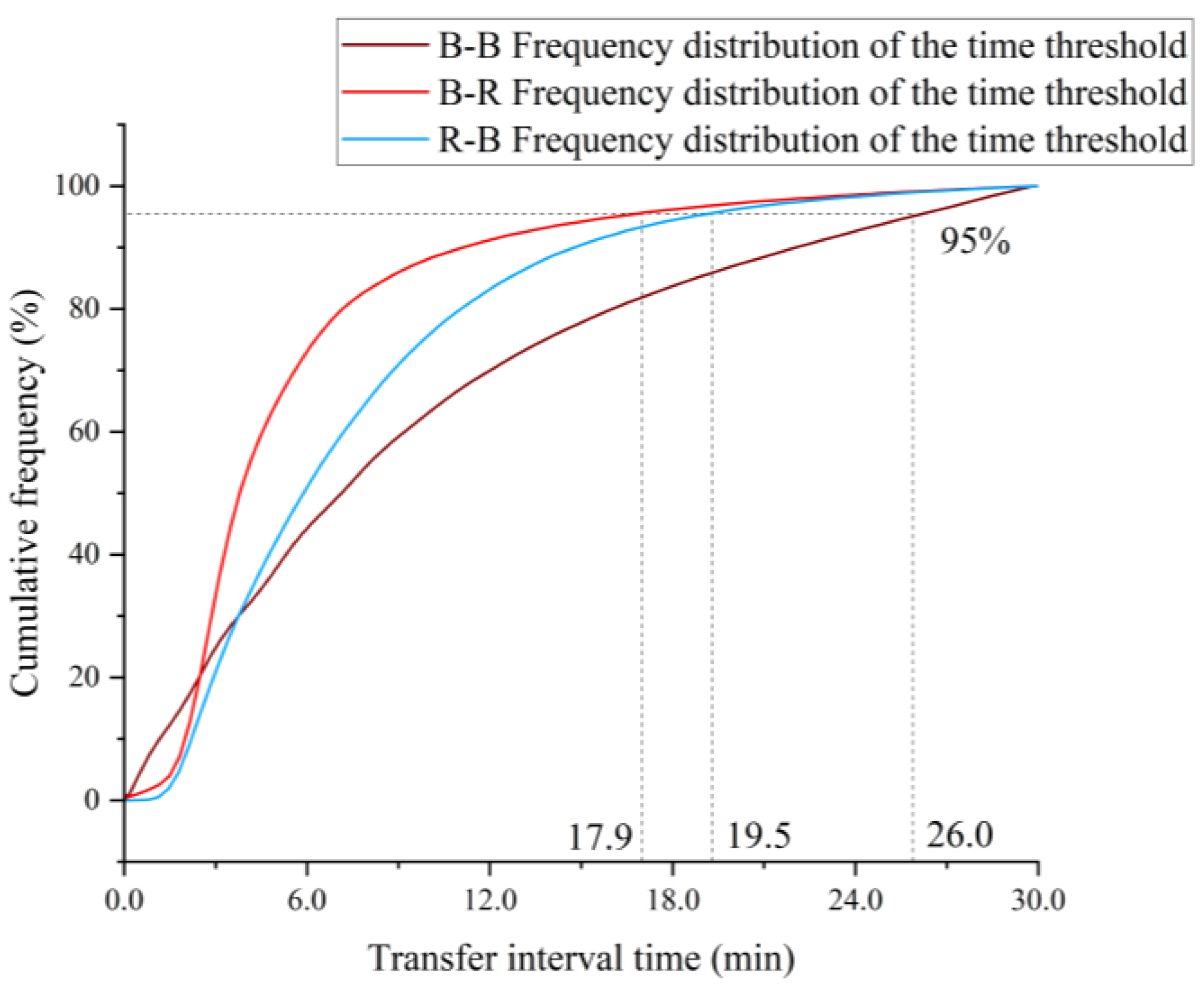
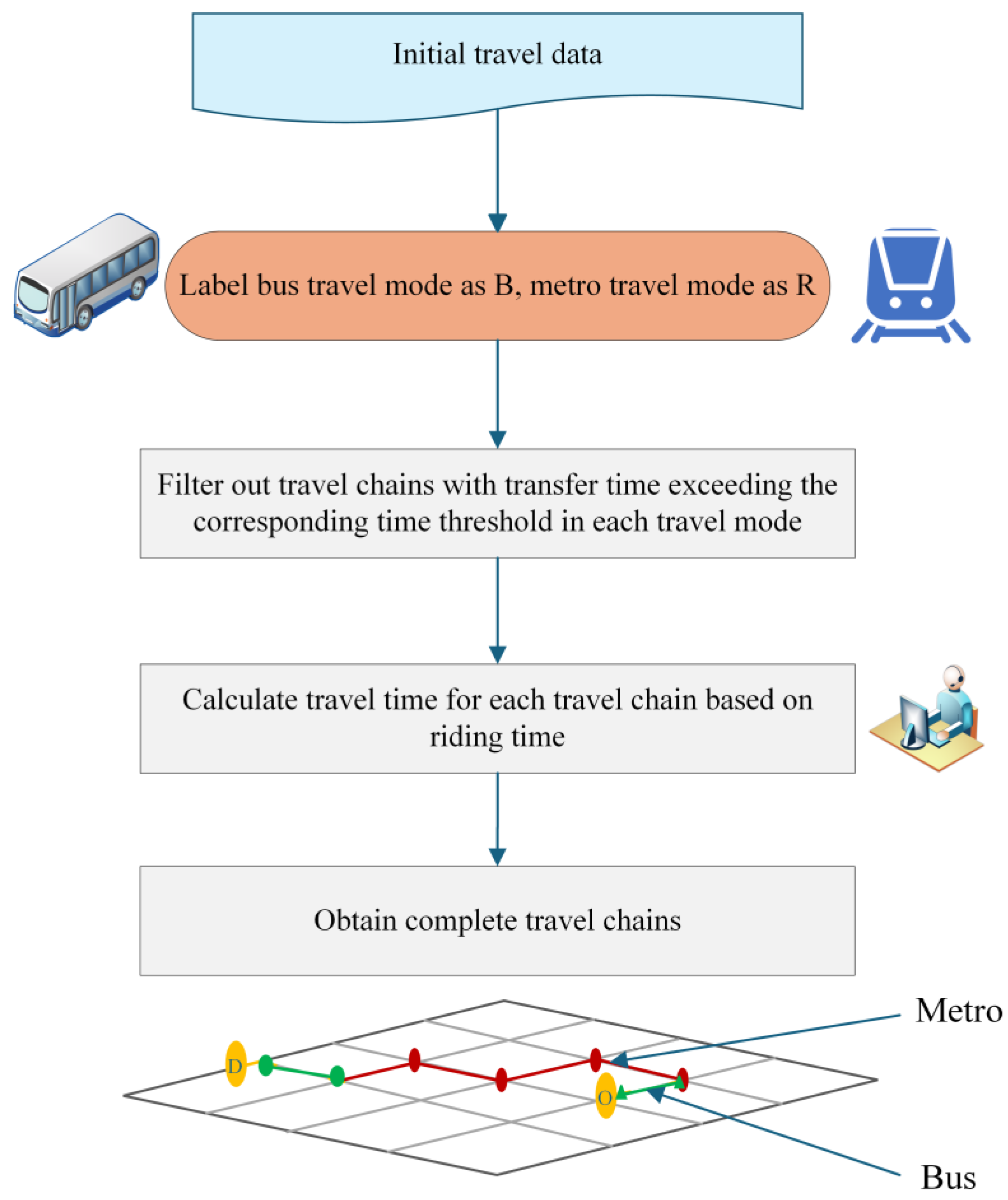
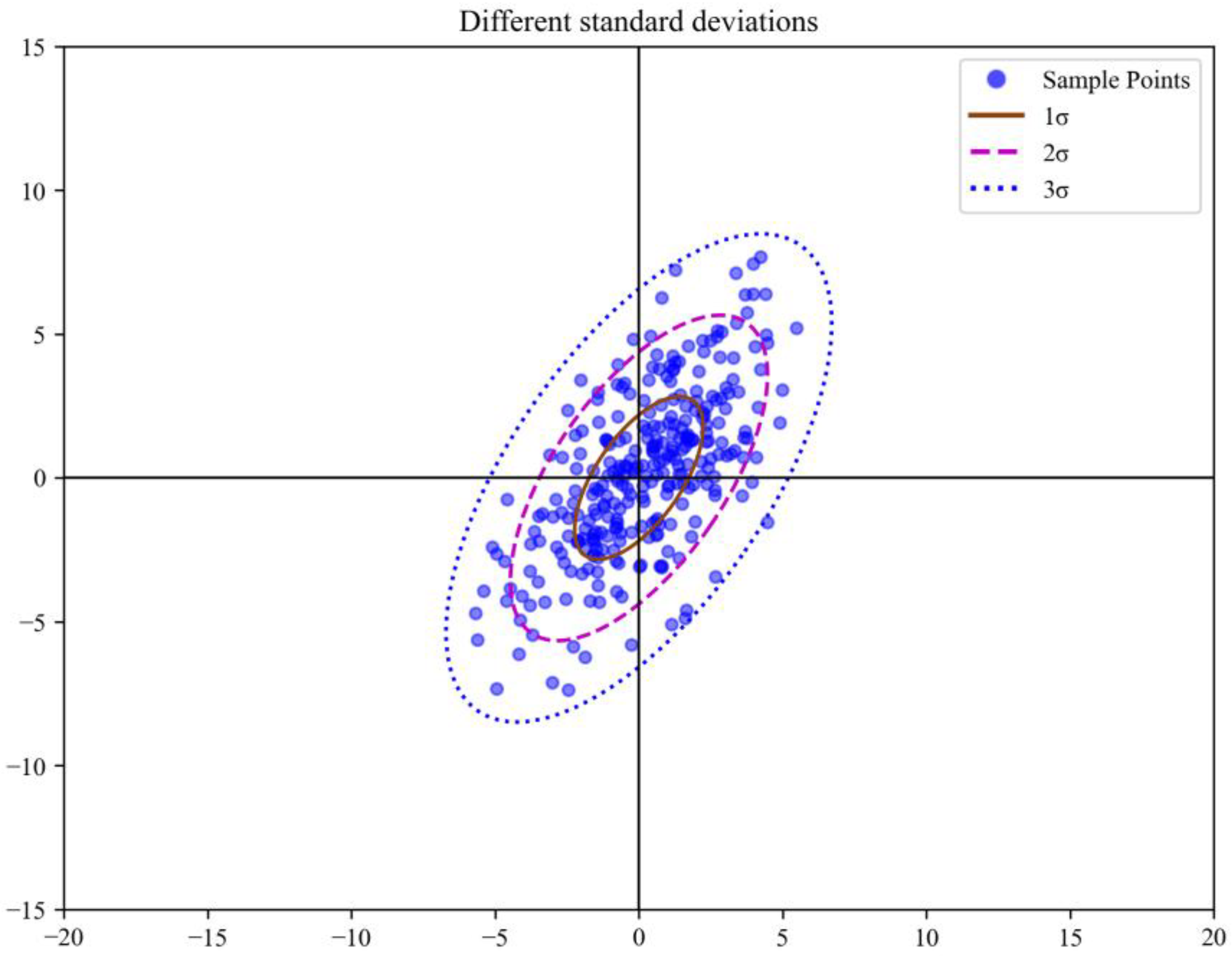
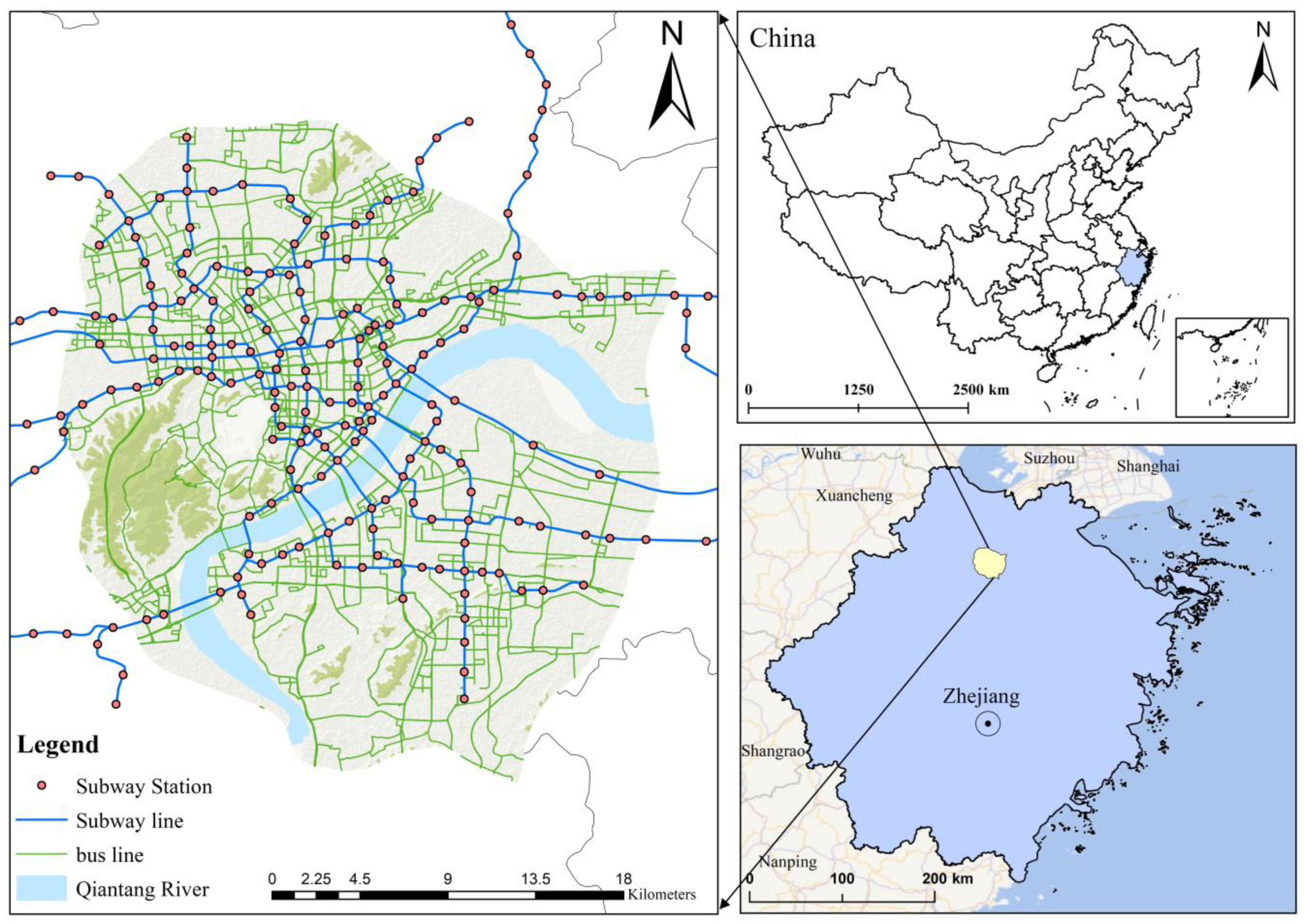


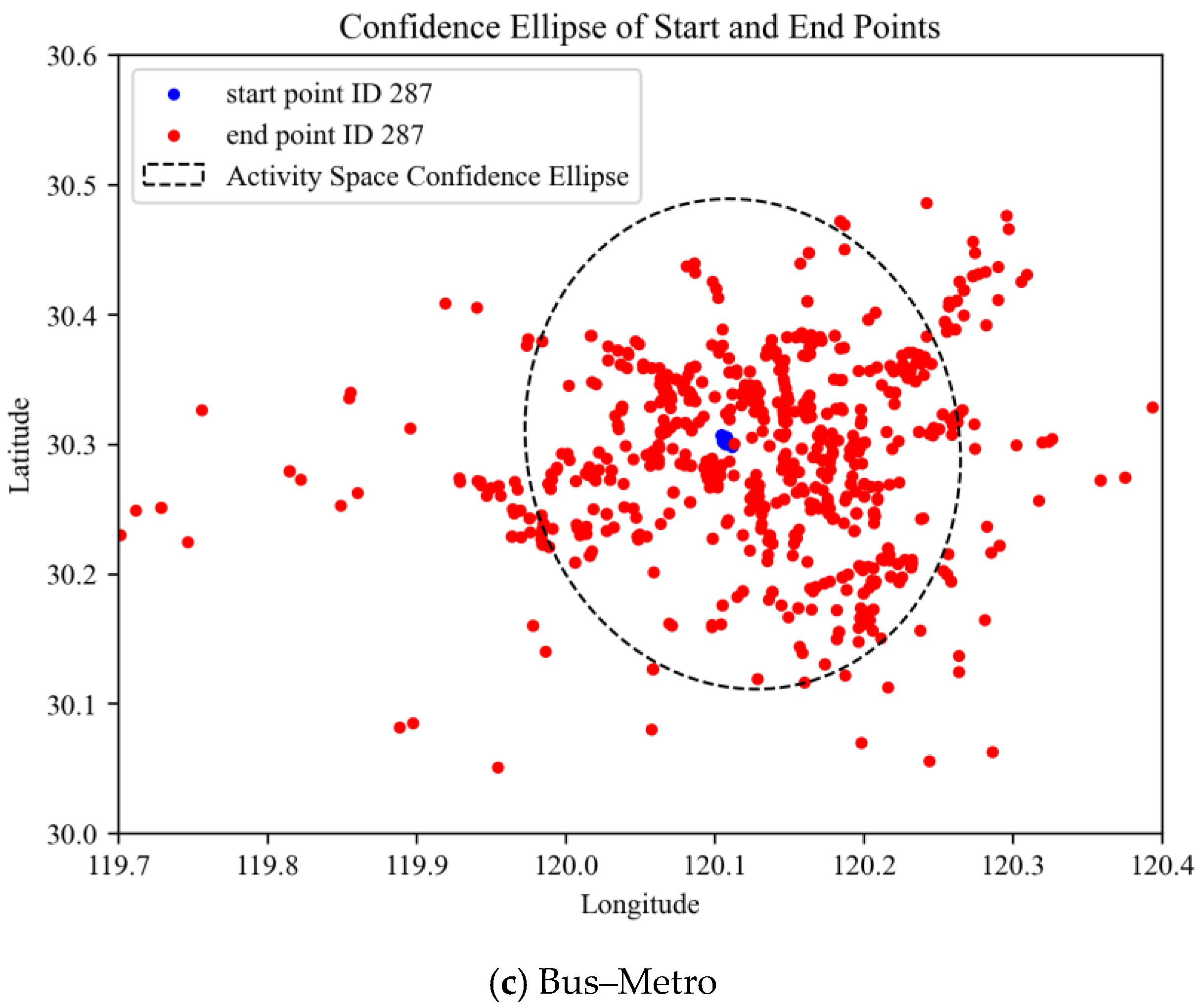
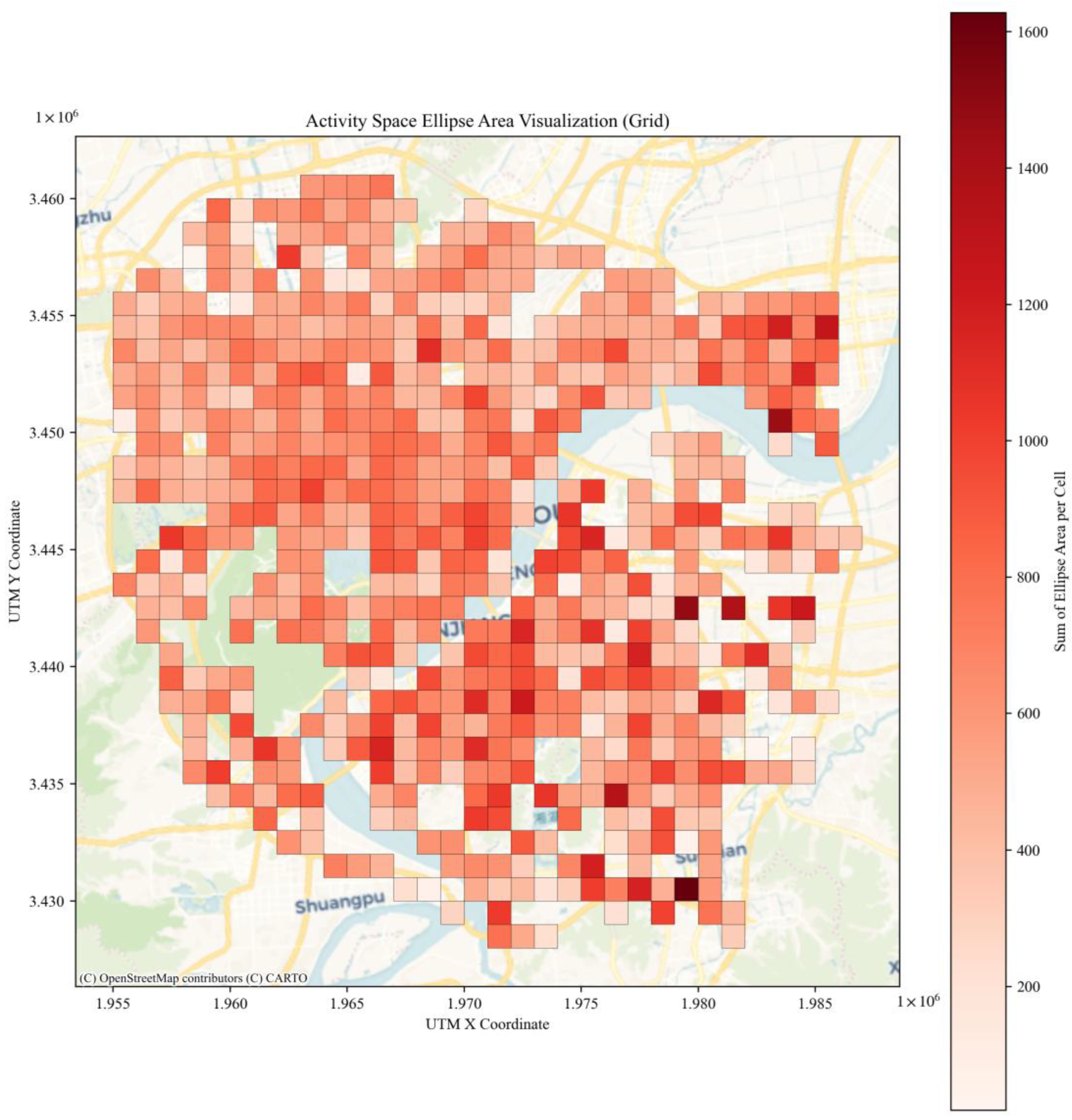

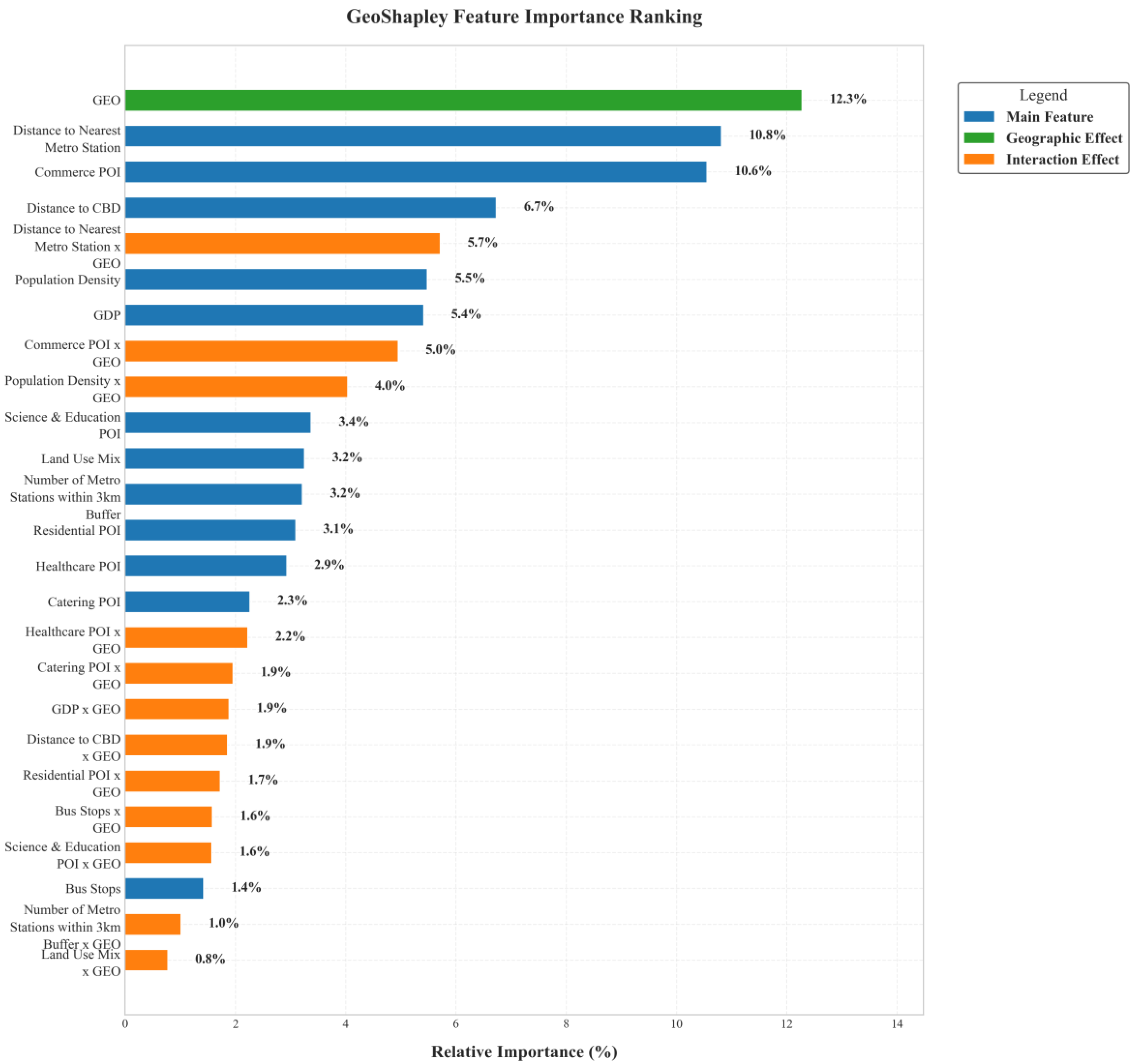
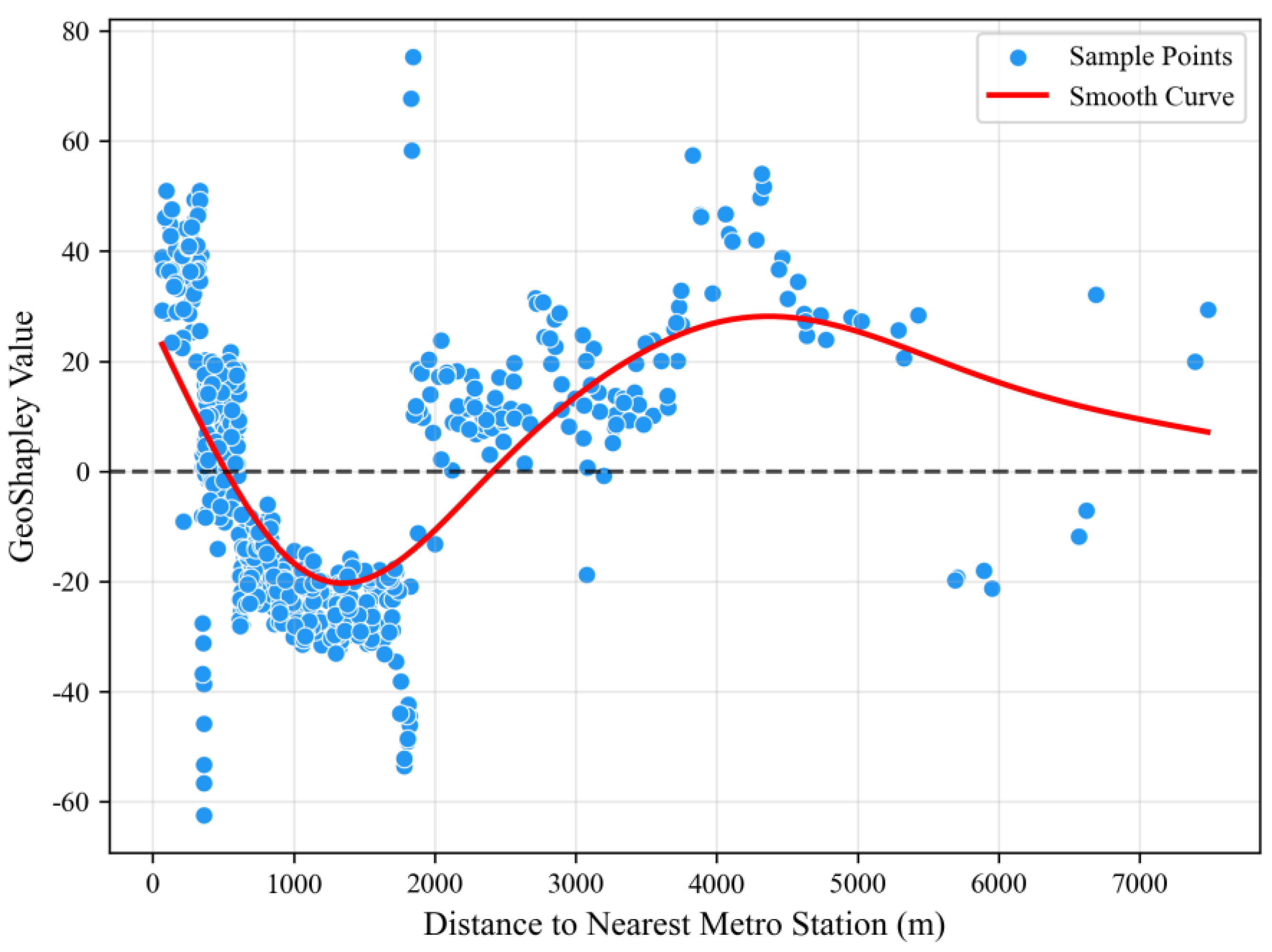

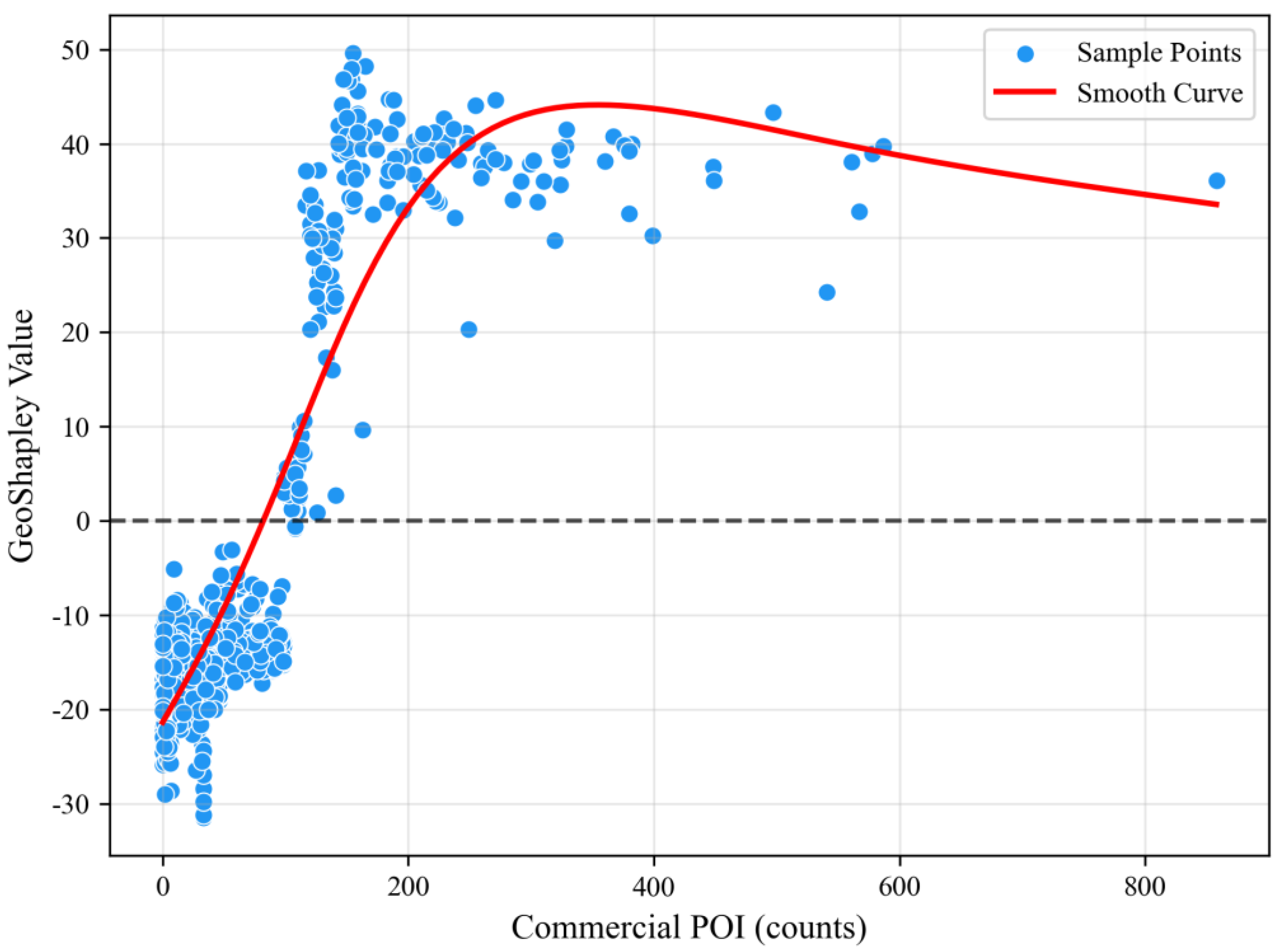
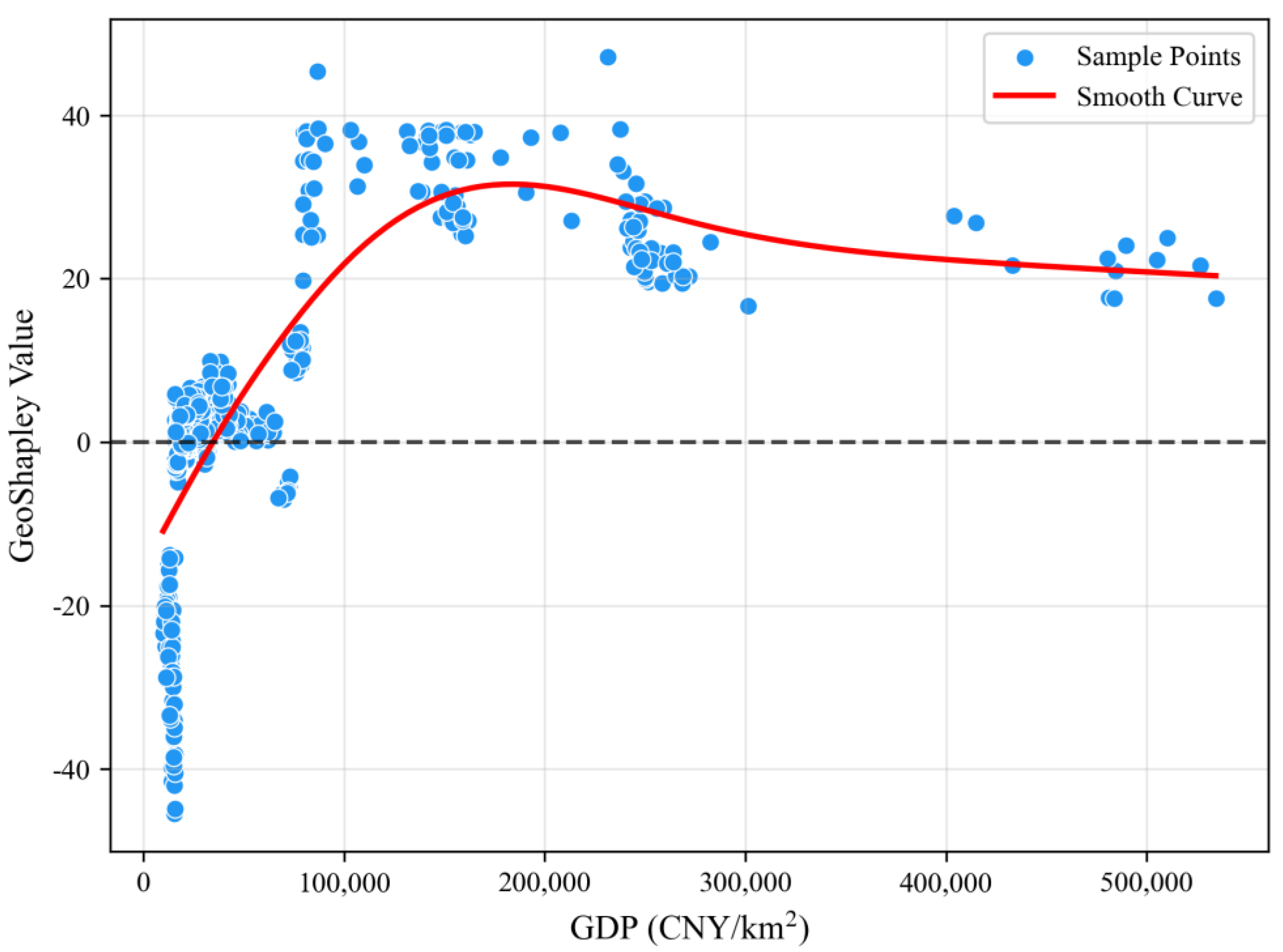
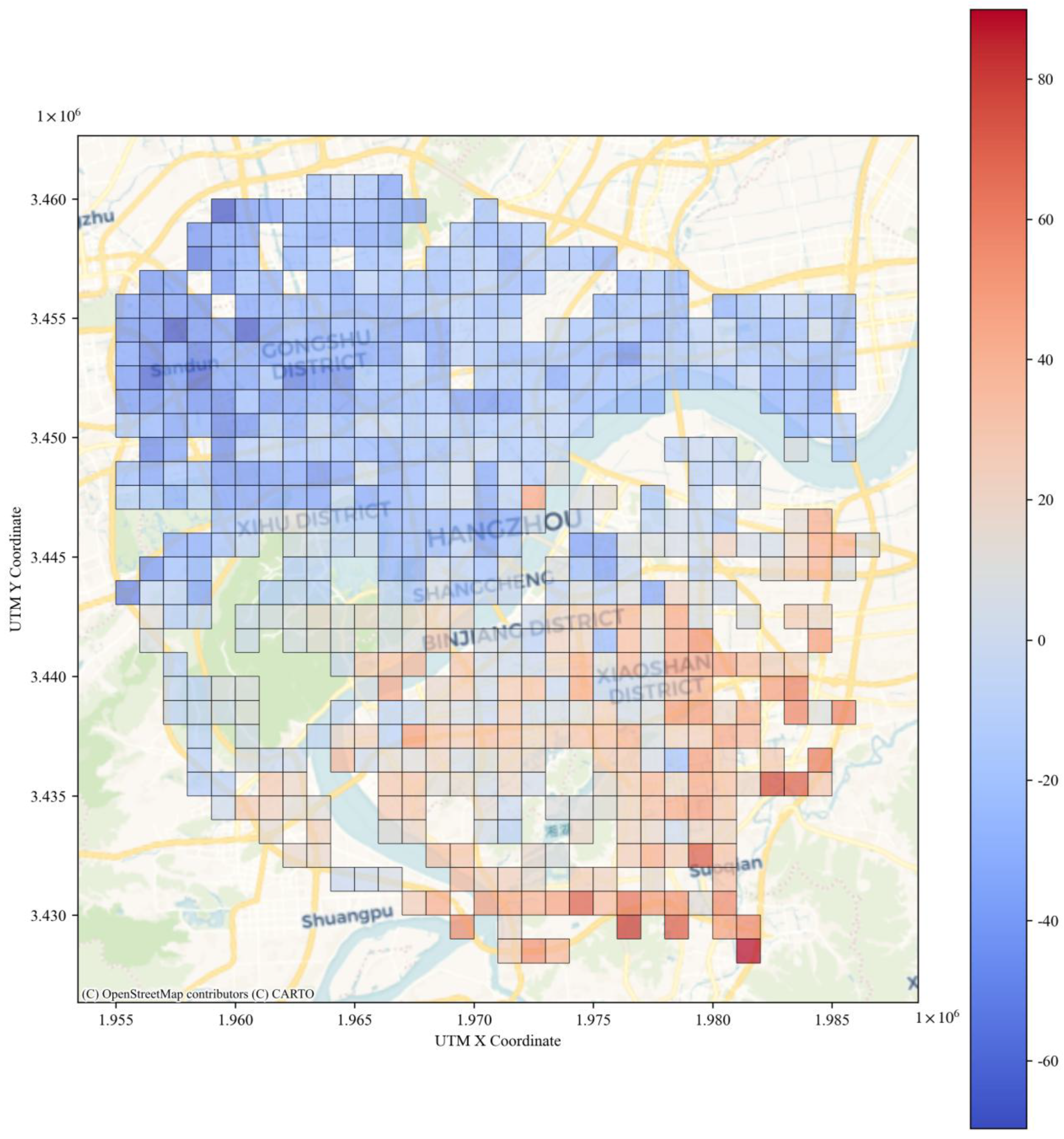

| Author(s) and Year | Core Concept/Contribution | Measurement Method/Approach |
|---|---|---|
| Hägerstrand (1970) [17] | Introduced the foundational concept of “space-time prisms” from time–geography, focusing on individual constraints. | Conceptual framework for potential activity space under spatiotemporal constraints. |
| Newsome et al. (1998) [20] | Emphasized commuters’ spatially constrained activity structures. | Pioneered the use of elliptical models to statistically summarize the spatial distribution of activity locations. |
| Schönfelder & Axhausen (2003) [23] | Proposed a method to approximate travelers’ actual activity ranges by linking travel paths to surrounding areas. | Developed path buffer zones based on road network paths. |
| Buliung & Kanaroglou (2006) [21] | Achieved more precise depictions by incorporating non-work activity locations anchored by household members. | Utilized convex polygon models to delineate accessible spaces. |
| Yu & Shaw (2008) [27] | Advanced visualization to overcome the limitations of 2D representations. | Designed a 3D spatiotemporal GIS framework to visualize human activities in both physical and virtual spaces. |
| Zhou et al. (2015) [24] | Focused on identifying functionally important nodes and analyzing spatiotemporal travel patterns in an urban network. | Introduced the “Functional Crucial Network Location” (FCNL) concept using taxi trajectory data. |
| Card_ID | Arrival Time | Arrival Station | Departure Station | Departure Time | Record_ID |
|---|---|---|---|---|---|
| 20883******074000 | 1 November 2023 13:31 | Jiuhe Road Station | Wulin Square Station | 1 November 2023 13:54 | R580353 |
| 48801******498800 | 1 November 2023 13:10 | Puyan Station | Chengzhan Station | 1 November 2023 13:40 | R549797 |
| 20880******668200 | 1 November 2023 7:53 | Nanxingqiao Station | Jiangjin Road Station | 1 November 2023 8:05 | R2017405 |
| Card_ID | Arrival Time | Arrival Station | Departure Station | Departure Time | Record_ID |
|---|---|---|---|---|---|
| 31000******282500 | 1 November 2023 11:16 | Liaojia | Hangzhou Ecological Park | 1 November 2023 11:36 | B797670 |
| 31007******655500 | 1 November 2023 19:08 | Liuxia North | Kechuang Road | 1 November 2023 19:47 | B13021 |
| 31007******0042900 | 1 November 2023 7:07 | Guanshan Park | Hengshan Xia | 1 November 2023 7:38 | B92135 |
| Start_Lng | Start_Lat | End_Lng | End_Lat | ID |
|---|---|---|---|---|
| 120.2159041 | 30.18973507 | 120.1630861 | 30.24830757 | 6 |
| 120.2159041 | 30.18973507 | 120.2318913 | 30.23485885 | 6 |
| 120.2159041 | 30.18973507 | 120.377064 | 30.2889447 | 6 |
| 120.2159041 | 30.18973507 | 120.1454889 | 30.2824606 | 6 |
| 120.2159041 | 30.18973507 | 120.1353786 | 30.28559813 | 6 |
| 120.2159041 | 30.18973507 | 120.1443834 | 30.31011878 | 6 |
| 120.2159041 | 30.18973507 | 120.2066327 | 30.24716781 | 6 |
| 120.2159041 | 30.18973507 | 120.4285616 | 30.23783798 | 6 |
| 120.2159041 | 30.18973507 | 120.1932701 | 30.23320226 | 6 |
| Variables | Description | Mean | Min | Max |
|---|---|---|---|---|
| Dependent variable | ||||
| Area of Activity Space | Area of the confidence ellipse for each grid (km2) | 606.92 | 10.00 | 1627.89 |
| Socioeconomic attributes | ||||
| GDP | Per capita GDP in the grid (CNY/km2) | 62,928.44 | 9867 | 53,4418 |
| Built environment | ||||
| Catering POI | Number of catering POIs in the grid (counts) | 109.50 | 0.00 | 1197.00 |
| Commercial POI | Number of commercial POIs in the grid (counts) | 77.52 | 0.00 | 858.00 |
| Science and education POI | Number of science and education POIs in the grid (counts) | 18.24 | 0.00 | 152.00 |
| Residential POI | Number of residential POIs in the grid (counts) | 15.39 | 0.00 | 116.00 |
| Healthcare POI | Number of healthcare POIs in the grid (counts) | 16.51 | 0.00 | 232.00 |
| Population density | Population density in the grid (pop) | 5153.76 | 962.87 | 22,241.18 |
| Distance to CBD | Euclidean distance from the grid center to the CBD (m) | 10,657.06 | 232.57 | 21,478.29 |
| Number of Metro Stations within 3 km Buffer | Number of metro stations within a 3 km buffer of the grid center (counts) | 11.75 | 0.00 | 45.00 |
| Bus stops | Number of bus stops in the grid (counts) | 5.68 | 0.00 | 22.00 |
| Land use mix | Degree of land use mix | 0.67 | 0.00 | 0.97 |
| Distance to Nearest Metro Station | Distance from the grid center to the nearest metro station (m) | 1360.63 | 65.05 | 7481.26 |
| Training Set R2 | Test Set R2 | |
|---|---|---|
| XGBoost + GeoShapley | 0.513 | 0.432 |
| XGBoost (no GEO) | 0.395 | 0.317 |
| Random Forest | 0.362 | 0.328 |
| OLS | 0.189 | 0.115 |
| GAM | 0.227 | 0.213 |
Disclaimer/Publisher’s Note: The statements, opinions and data contained in all publications are solely those of the individual author(s) and contributor(s) and not of MDPI and/or the editor(s). MDPI and/or the editor(s) disclaim responsibility for any injury to people or property resulting from any ideas, methods, instructions or products referred to in the content. |
© 2025 by the authors. Published by MDPI on behalf of the International Society for Photogrammetry and Remote Sensing. Licensee MDPI, Basel, Switzerland. This article is an open access article distributed under the terms and conditions of the Creative Commons Attribution (CC BY) license (https://creativecommons.org/licenses/by/4.0/).
Share and Cite
Guo, K.; Tang, R.; Pan, H.; Zhang, D.; Liu, Y.; Shi, Z. Activity Spaces in Multimodal Transportation Networks: A Nonlinear and Spatial Analysis Perspective. ISPRS Int. J. Geo-Inf. 2025, 14, 281. https://doi.org/10.3390/ijgi14080281
Guo K, Tang R, Pan H, Zhang D, Liu Y, Shi Z. Activity Spaces in Multimodal Transportation Networks: A Nonlinear and Spatial Analysis Perspective. ISPRS International Journal of Geo-Information. 2025; 14(8):281. https://doi.org/10.3390/ijgi14080281
Chicago/Turabian StyleGuo, Kuang, Rui Tang, Haixiao Pan, Dongming Zhang, Yang Liu, and Zhuangbin Shi. 2025. "Activity Spaces in Multimodal Transportation Networks: A Nonlinear and Spatial Analysis Perspective" ISPRS International Journal of Geo-Information 14, no. 8: 281. https://doi.org/10.3390/ijgi14080281
APA StyleGuo, K., Tang, R., Pan, H., Zhang, D., Liu, Y., & Shi, Z. (2025). Activity Spaces in Multimodal Transportation Networks: A Nonlinear and Spatial Analysis Perspective. ISPRS International Journal of Geo-Information, 14(8), 281. https://doi.org/10.3390/ijgi14080281






